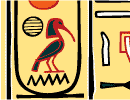by Karol
Mysliwiec
The western part of Saqqara has long been considered the wrong side of
the ancient Egyptian tracks, a low-rent district within the fabled burial
ground of pharaohs. Archaeologists assumed there was little to be found
there except old stone quarries and refuse heaps. They were wrong.
|

Zbigniew Kosc |
|
Excavating in the untapped desert just west of the Step Pyramid, tomb
of King Djoser, our team of Warsaw University Egyptologists discovered
burials that span almost 4,000 years. Among them was the beautifully
preserved and colorful tomb of a powerful Egyptian politician, a
previously unknown vizier named Fefi.
A vizier was a sort of prime minister, the right hand of the pharaoh.
Fefi, whose "great name" was Meref-nebef, seems to have been the life of
the party in the twenty-fourth century B.C. The tomb's murals and
hieroglyphs describe him cavorting with a woman known as "The One Who
Loves Life." His five wives apparently were stuck at home, and political
enemies - perhaps his own sons - jockeyed bitterly for power.
Fefi lived late in the reign of King Teti, first ruler of the Sixth
Dynasty, a time of turbulence and discord. The Old Kingdom, the first
glorious chapter of Egyptian history, had disintegrated into political
chaos and civil war as the Sixth Dynasty ended around 2200 B.C. Great
power seems to have passed during this dynasty into the hands of the
bureaucracy, especially the vizier, who controlled much of the nation's
financial and administrative affairs.
Fefi's tomb already offers fresh hints into the life and politics of
the time. But much work remains, including the continuing search for the
mummy of Vizier Fefi.
The First Pyramid
The world's oldest pyramid dominates the necropolis at Saqqara, in
which kings and noblemen were buried from the very beginning of Egyptian
history. Saqqara, about 20 kilometers (12 miles) south of today's Cairo,
is just a part of Pharaonic Egypt's largest royal cemetery, which extends
along a rocky plateau at the edge of the desert, parallel to the Nile
River. This enormous field of pyramids (the tombs of pharaohs and their
families) and mastabas (the less-imposing tombs of noblemen and early
pharaohs) was the necropolis of ancient Memphis, the legendary capital in
which pharaohs were crowned during the Old Kingdom.
Egypt's wondrous pyramids began with the Step Pyramid at Saqqara, built
about 2700 B.C. for King Djoser by his master architect, Imhotep.
The city of Memphis, with its great palaces and temples, has been
almost completely erased by the stormy winds of Egyptian history, but the
pyramids - the final resting place of kings - still bear proud witness to
its glorious past.
Nobles and rich commoners, meanwhile, apparently wanted to share in the
pleasures of the afterlife and, perhaps, to bask in the reflected glory of
the pharaohs. They built mastabas as their graves. These were low, flat
structures, made of mud bricks or stone, that resembled benches (mastaba
translates to bench in Arabic).
Beneath the surface structure was a series of shafts dug into the
bedrock that included offering rooms and a chapel. The crypt itself might
be at the bottom of a pit excavated still deeper into the ground. It was
such a tomb that we found west of the Djoser pyramid.





